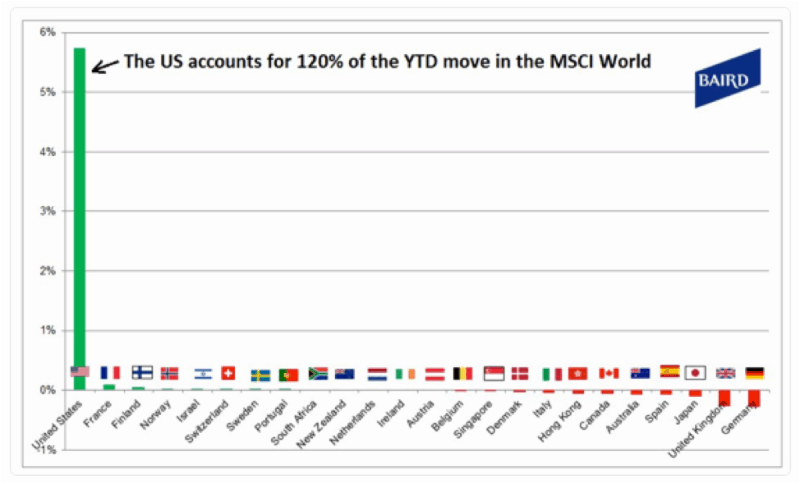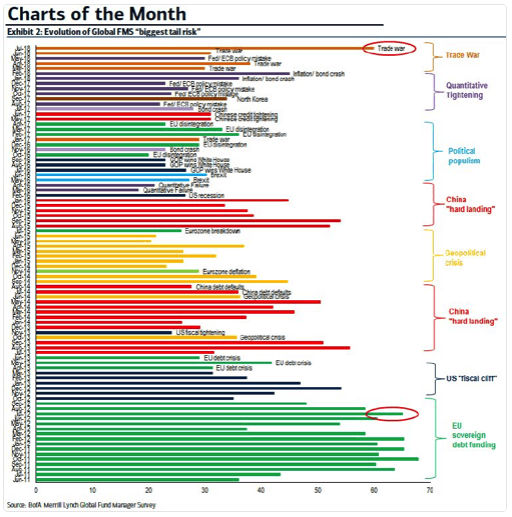Mixed Messages, Mixed Week
The major domestic equity indexes closed mixed for a second consecutive week, with the technology-heavy Nasdaq Composite recording a solid gain, while most other benchmarks suffered declines. Along with tech stocks, consumer discretionary shares outperformed within the S&P 500, while materials and financials shares declined. Similarly, faster-growing, higher-valuation growth stocks handily outperformed value. Last week saw a number of positioning trades on the part of pension funds and other institutional investors ahead of the end of the third quarter. Friday brought the unveiling of a new communication services sector within the S&P 500, which replaces the small telecommunication services sector and encompasses several Internet-related firms formerly categorized within either the consumer discretionary or information technology sectors, including Alphabet (parent of Google), Facebook, and Netflix, which all have heavy weights in the new sector.
Macroeconomic and policy concerns continue to play a large role in driving the market. As new tariffs on imports from China took effect Monday, the escalating trade conflict weighed on sentiment, especially after Chinese officials stated that they would not attend high-level talks in Washington. Accusations from President Donald Trump that China was attempting to interfere in the U.S. midterm elections and worries that Mr. Trump might fire Deputy Attorney General Rod Rosenstein may have also unsettled traders. One prominent stock-specific development was the announcement of an SEC civil suit against Tesla CEO Elon Musk, which sent shares of the electric automaker down by roughly 12 percent in early trading Friday.
The Federal Reserve announced it would raise short-term interest rates by another quarter-percentage point last week, and Fed officials signaled they want to continue lifting them through the next year to keep a strong economy on an even keel. Officials voted unanimously on the increase, which will bring the benchmark federal-funds rate to a range between 2 and 2.25 percent. Most officials expect to raise rates one more time this year, according to projections released after the meeting. This increase was the third this year and the eighth since the Fed began to lift rates in late 2015, after keeping them pinned near zero after the 2008 financial crisis. The Committee boosted its GDP growth forecast for 2018 and 2019. However, the FOMC’s “longer-run” U.S. GDP growth forecast (after the impact of the tax cuts have dissipated) remains below 2 percent. There was also a slight adjustment to next year’s consumer inflation expectation.
One additional development that gathered notice was the absence of the word “accommodative” in the Fed’s description of the stance of current monetary policy. Most analysts still believe that Fed officials view their stance as generally accommodative, however. When accounting for inflation, the current fed funds rate is barely positive. Moreover, as noted above, policymakers stress that they expect to continue raising rates — an unlikely assurance if they believed that they were removing accommodation and slowing the economy.
Longer-term U.S. Treasury yields decreased slightly for the week, although the benchmark 10-year U.S. Treasury note briefly touched a four-month high of 3.11 percent on Tuesday. A drop in yields on Wednesday appeared to be due in part to dovish comments on inflation from Fed Chairman Jerome Powell following the central bank policy meeting. The lack of any changes in the “dot-plot” survey of individual policymakers’ expectations for future interest rates may have also played a role.
After rising for much of the week, European stocks lost ground after Italy’s coalition government agreed to a wider-than-expected 2019 budget deficit goal of 2.4 percent, triple what the previous government had planned. The decision essentially puts the country on a collision course with the European Union, which had urged Italy to rein in its spending. The deal will likely prompt all three major credit ratings agencies to downgrade Italy and put it on negative watch, which could add to the selling pressure on Italian assets.
European markets have been volatile for months since the populist coalition partners suggested that they might breach EU deficit targets to fulfill campaign promises, but the deficit target was wider than markets expected. Following the announcement, the 10-year Italian government bond yield rose as high as 3.26 percent. On the week, the pan-European STOXX Europe 600 Index fell slightly, but Italy’s FTSE MIB Index dropped about 4 percent. The euro also sold off and finished the week about one percent lower against the U.S. dollar.
In Asia, China’s main stock indexes rose for the second week in a row as proposals from competing index providers to include more yuan-denominated shares into global portfolios offset the latest round of U.S. tariffs taking effect. For the week, the benchmark Shanghai Composite Index added 0.9 percent while the large-cap CSI300 Index rose 0.8 percent. Mainland Chinese markets are closed the first week of October for the National Day holiday.
Elsewhere in Asia, Japanese stocks posted solid gains in the holiday-shortened trading week (the Tokyo Stock Exchange was closed on Monday for Autumnal Equinox Day, which celebrates the arrival of fall). For the week, the Nikkei 225 Stock Average advanced 250 points (1.05 percent) and closed up 5.95 percent YTD. The broad-based TOPIX Index and the TOPIX Small Index also rallied for the week, but their returns YTD are still slightly in negative territory.
In the decade since the global financial crisis, people around the world are understandably far more bullish about the state of their economies than they were in the aftermath of the crisis. For example, in the U.S., 65 percent believe that the economy is in good shape, compared to 17 percent in 2008. However, in a dramatic shift from the past, many in the developed world doubt the good times will last for the coming generation. Only around one-third of respondents in the U.S., Germany, and Sweden think their children will be better off economically than they are. That number is just 25 percent in Canada and the U.K., and 15 percent in France and in Japan. Answers vary widely in emerging economies, but India (66 percent), Nigeria (65 percent) and Indonesia (75 percent) are particularly optimistic.
Other news and notes follow.
- The share of the world in extreme poverty is shrinking.
- Last Monday, oil topped $80 for the first time since May and logged its highest settle since November 2014. The global benchmark is up 21 percent in 2018.
- Nike shares, up 35 percent this year, have climbed 18 percent since the athletic-apparel maker’s previous earnings report and have risen 3 percent since the company rolled out its new advertising campaign with NFL quarterback-turned-activist Colin Kaepernick.
- Ten years ago last week, in the depths of the financial crisis, federal regulators seized Washington Mutual and struck a deal to sell the bulk of its operations to JPMorgan. It was the largest bank failure in U.S. history.
- Silicon Valley tech giants can’t be trusted to police themselves and should be subject to tougher regulation, according to a critical new report.
- President Trump signed a revised free-trade pact with South Korea, his first successful effort to open rather than close off trade channels, albeit only modestly.
- About 70 percent of Americans say it’s “very important” or “somewhat important” to buy American-made goods. But only 21 percent would pay 10 percent more for an American-made product and only 7 percent said they would pay 50 percent more, according to a Reuters/Ipsos poll.
- The economic outlook among chief executives of America’s largest companies cooled slightly in the third quarter, as confrontational U.S. trade policies weighed on planning for capital spending and hiring.
- A spike in U.S. mortgage rates on account of rising interest rates is spooking traders in some market sectors. While mortgage rates are still low by historical standards, a sharp increase combined with rapidly rising home prices can substantially dampen demand.
- The September Richmond Fed regional manufacturing index hit its highest level on record. U.S. factories are firing on all cylinders.
- The Conference Board’s consumer confidence index touched its highest level since 2000, driven by a booming jobs market.
[ctct form=”269″]









